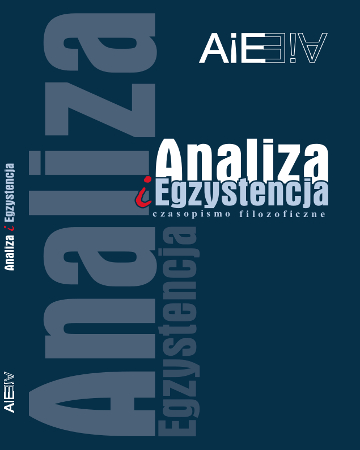
ISSN: 1734-9923
eISSN: 2300-7621
OAI
DOI: 10.18276/aie.2019.48-05





Issue archive /
48 (2019)
Intencjonalność dzieła sztuki w filozofii kultury Josepha Margolisa i w fenomenologicznej estetyce Romana Ingardena
(Intentionality of a Work of Art in Joseph Margolis’ Metaphysics of Culture and Roman Ingarden’s Phenomenological Aesthetics)
| Authors: |
Aleksandra
Łukaszewicz Alcaraz
Akademia Sztuki w Szczecinie |
| Keywords: | Intentionality institution intentional object the work of art |
| Data publikacji całości: | 2019 |
| Page range: | 15 (89-103) |
Abstract
Extremaly interesting contemporary proposal on the perception of the work of art through the prism of philosophy of culture, as it is presented by Joseph Margolis, points at the specific form of being of the artwork, on its’ ontology of an intentional being. Specifying Intentionality as the characteristics of cultural entities, based on their various forms of appearance and on their openess on interpretation and reidentification in different ways of embodiement. Margolis discusses on the grounds of analystic philosophy, and – when its’ possibilties expire – takes up a dialogue with phenomenological tradition, emerging from Franz Brentano and Edmund Husserl. It is interesting that there lack a reference to Roman Ingarden and his idea of the work of art as an intentional object, though the Margolis’ grasp on the Intentionality as the characteristics of the being of the work of art (and of other cultural entitietos) is close to Ingarden’s understanding of the work of art as an intentional object. Both of them posit the work of art on the third ontological level, neither on physical, nor on ideal, but on the cultural level, which exist factually.
Download file
Article file
Bibliography
| 1. | Bokiniec, M. (2004). ‘”To, co nie zostało napisane”. Josepha Margolisa koncepcja realizmu kulturowego, w: Estetyka i Krytyka, Vol. 6., No. 1. |
| 2. | Brentano, F. (1999). O różnicy między fenomenami psychicznymi i fizycznymi (Księga 2, rozdz. I) w: Psychologia z empirycznego punktu widzenia, red. Hanna Marciniak, Warszawa: PWN. |
| 3. | Ingarden, R. (1946). ”O dziele architektury”, Odbitka z czasopisma „Nauka i Sztuka”, styczeń – luty 1946, No. 1/2. |
| 4. | Ingarden, R. (1948). ”Utwór muzyczny i sprawa jego tożsamości”, Studia z estetyki. T. 2, Warszawa. |
| 5. | Ingarden, R. (1960). O dziele literackim. Badania z pogranicza antologii, teorii języka i filozofii, przeł. M. Turowicz, Warszawa: PWN. |
| 6. | Ingarden, R. (1966a). Studia z estetyki. T. 3, Warszawa: PWN. |
| 7. | Ingarden, R. (1966b). ”O zagadnieniu percepcji dzieła muzycznego”, Przeżycie, dzieło, wartość, Kraków. |
| 8. | Ingarden, R. (1973). Utwór muzyczny i sprawa jego tożsamości, Kraków: Polskie Wydawnictwo Muzyczne. |
| 9. | Ingarden, R. (1975). Książeczka o człowieku, Kraków: Wydawnictwo Literackie. |
| 10. | Margolis, J. (1986). Intentionality, Institutions, and Human Nature, “The Monist”, Vol. 69, No. 4, Intentionality. October. Oxford University Press, (ss. 546-567) |
| 11. | http://www.jstor.org/stable/27902998. |
| 12. | Margolis, J. (2003). Selves and Other Texts, University Park, Pa.: Pennsylvania State University Press; London: Eurospan. |
| 13. | Margolis, J. (2004). Czym, w gruncie rzeczy, jest dzieło sztuki? Wykłady z filozofii sztuki, red. Krzystyna Wilkoszewska, przeł. Wojciech Chojna, Krzysztof Guczalski, Marzenna Jakubczak, Krystyna Wilkoszewska, Kraków: Universitas, 2004. |
| 14. | Margolis, J. (2017). Three Paradoxes of Personhood. The Venetian Lectures, red. Roberta Dreon, Hermann, Mimesis International. |
| 15. | Mitscherling, J., Fairfield, P. (2019). Artistic Creation. A Phenomenological Account, Lanham-Boulder-New York-London: Lexington Books. |
| 16. | Popper, K. R. (1950). The Open Society and Its Enemies, Princeton, NJ: Princeton University Press. |
| 17. | Ruthrof, H. (1992). Pandora and Occam. On the Limits of Language and Literature, Bloomington: Indiana University Press. |
| 18. | Thomasson, A. (2005). ”Ingarden and the Ontology of Cultural Objects”, Exstence, Culture, and Persons: The Ontology of Roman Ingarden. |